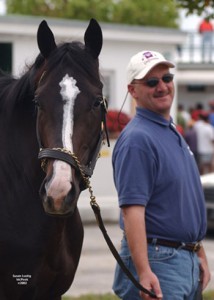The Head Trainer – All The Glory, All The Blame
In his book, Ainslie’s Complete Guide to Thoroughbred Racing, Tom Anslie said:
The truth is that racing is no more natural for horses than the hundred-yard dash is for men. To engage successfully in activities of that kind, a horse (or man) must be schooled and tended. To survive any great number of races or training workouts without breaking down, the muscles, joints, heart and lungs of horse or man must be trained for undue stress.
The trainer is the man (or woman) who is responsible for the proper feeding, exercising, and preparing of the horse to run in races. Like the head coach of a sports team, he doesn’t always perform these tasks directly, but utilizes the help of his staff. Also, just like a professional sports team has assistant coaches, trainers rely on the help of their assistant trainers. Especially the top trainers who frequently have horses at multiple racetracks, and require assistants and others to tend to their horses on a daily basis.
However, similar to other professional sports, ultimately the head trainer is the person responsible for everything that happens with a horse while in his or her care. In the public’s eyes, the head trainer gets all the glory, as well as all the blame.
I have had the opportunity to meet with some trainers in recent years, and overall I must say they are some of the hardest working people I’ve ever known. Up before dawn to tend to their horses in the morning, off to the racetrack in the afternoon, and then back to their horses and business in the evening. As one trainer told me, “7 days a week, 52 weeks a year. Horses still have to be cared for, even when they’re not racing.”
One time I asked a trainer, is it harder to train some horses than others? He replied:
The good horses, stakes caliber that is, are generally easier to care for. They are structurally sound, well put together. Because of that, they don’t have the propensity for physical ailments that lesser caliber horses do.
In explaining this to me, I had an “Ah Ha” moment. I had often wondered why some horses seem to be inconsistent. They might have one good race, but then have a clunker, or maybe be off for six months without any races. The explanation provided to me by the trainer caused me to imagine a horse with a trick knee or foot … who races when sound, and maybe gets involved in an all-out battle to try to win. And, in exerting himself in the race, maybe he aggravates his condition. Then subsequent to that race he needs time to recover, and to get back into racing form again. All of this makes more sense to me now.
As with other individuals in horse racing, there is quite a wide variety of personalities when it comes to head trainers. Some of them are very soft spoken, others are brash. Some try to produce winners their first time out of the starting gate, others are willing to accept some losses, with the expectation of bigger wins down the road. Some excel at dirt sprint races, others at turf route races. Some excel in the Claiming game, while others rarely if ever Claim a horse.
With all of this variety in each trainer’s strengths and weaknesses, it’d be nice to have a way to see how a trainer’s horses perform under certain conditions. As it turns out, the online Daily Racing Form (a program called Formulator) provides the ability to analyze trainer statistics and discover tendencies a trainer might exhibit over a period of time. The handicapper has the ability to research up to five years of trainer statistics, and to see the results for inquiries such as:
- Turf vs. Dirt vs. Synthetic
- Sprint vs. Route
- Younger vs. Older Horses
- When using a specific jockey
- At specific race tracks
- By Class (e.g. Maidens, Claiming, Graded Stakes)
- Class Moves (e.g. Off a Maiden Win, First Time for a Tag)
- Off layoffs
- First time Routing, First time on Turf, First time off a claim
- Equipment changes (e.g. Blinkers On or Off)
These are just some of the categories you can use when searching for trainer tendencies. In future articles, I will discuss how you can incorporate these tendencies into your handicapping process.
Also, in the near future, we will be interviewing actual head trainers – from new guys (and gals) on the block to experienced trainers with many years under their belt. We will be spending more time backside with trainers as they go through their daily routines and learn more about how horses are “schooled and tended” to prepare them for the vigor of an actual race.
Click here to see a list of trainers we have interviewed in our “Meet The People” series.


2 comments on “The Head Trainer – All The Glory, All The Blame”